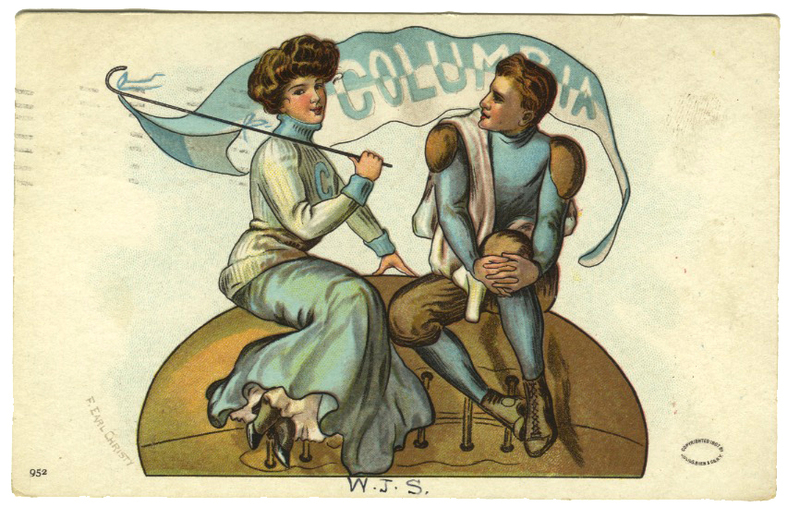Genevieve Hanna
Much like Julia Coleman, Genevieve Hanna's achievements reveal how women worked through social organizations in order to influence and strengthen their communities before holding the right to vote.
Born in 1878 in Stone Church, New York, Genevieve Hanna was the daughter of a Presbyterian minister, who arrived in Muncie in the very early 1900s. Her life is a study in balancing traditional expectations with more radical achievements. While Genevieve Hanna studied at several universities and taught in across Indiana, she also campaigned for women's siffrage, ran for public office led the Delaware County WWI homefront effort, and raised an adopted daughter on her own. Genevieve Hanna's life maintained traditional family relationships as a daughter, sister, and mother, at the same time that she carved out space for ambitious professional and political roles for women.
This biographical video was researched and created by Dave Flowers, Andrew Simmons, Becca Slevin, and Jayson Thomas.
Genevieve Hanna's early life was full of educational opportunities. In 1894, she graduated from high school in Canton, Ohio. At this time it was a substantial achievement, and most graduates came from high white-collar families or the upper-middle class. In 1896 in Muncie, female graduates outnumbered male graduates with 23 girls and 7 boys graduating.
Unlike most of her classmates, Genevieve continued studying. She attended Mount Union College, then Columbia University and the University of Chicago. Her devotion to learning makes a mockery of Earl Christy's postcard below. His "College Girl" never cracks a book and often appeared with a male co-ed. Christy's depiction of female students were a far cry from Genevieve's life as a scholar and teacher. Even when she stopped teaching (for a few years), in 1921 Genevieve attended summer classes at Columbia in New York City.
After teaching in Lima, Ohio, Gaston, Franklin and Yorktown, Genevieve Hanna returned to Muncie. She lived with her parents and sister at 407 University Avenue until her death in 1965. While she maintained a busy work and social life, what stands out is her ability to balance society's expectations of women with her own interests.
In the early 1900s, marriage and children were the chief goals that society set for women. Genevieve never married, but she did adopt a child sometime in the late 1920s. Knowing when and how is difficult as the federal census only counts households every ten years. Below are the Hanna housheold's census records for 1920 (top) and 1930 (bottom).
We can see that in ten years many things had changed. Genevieve had returned to teaching History and was hired by Muncie High School. Her father, Lyman, had died in 1927. Her sister, Lucille, had moved to St. Louis where she taught high school too. Even the neighbors on both sides of the house were different.
The 1930 census lists Suanne as 13 years old in 1930, and born in Tennessee. How and when she got to Muncie isn't clear. Did her parents migrate north looking for work? Did they die in Muncie? Did lose their jobs and leave her at the Children's Home when they could not care for her? Suddenly from 1927 Suanne (sometimes called Virginia), appears in Muncie newspapers accompanying her mother to visit Lucille in St. Louis and to Florida for Christmas break. Another notable woman, Mrs. M.C. Smith, had set up a Children's Home in Muncie to care for children who had been abandoned or orphaned. Perhaps this is how Genevieve came to adopt Suanne?
Twenty years later, the 1950 census shows a new household group at 407 University Avenue. Now 33 years old, Suanne is married to Charles Perry, an insurance agent, who is listed as household head. They have four children. The family lives together with Genevieve. Ironically, after a long life activism, education, work, travel, and family, in ways that were both traditional and radical for a woman who never married, Genevieve appears just as society expected: surrounded by family and community. This was surely the result of class and wealth privilege, which preserved both the house they lived in and the opportunities that Genevieve enjoyed.
To hear more about the historian's process and the methodologies used to research and create historical narratives, check out the conversation between Flowers, Simmons, Slevin and Thomas below.
Click on Anna Oakley / Minnie Fisher to meet a women without the educational opportunity that Genevieve Hanna had. Unfortunately, Minnie Fisher had neither the family nor the income support that Genevieve did. Her experience as a young woman in Muncie reminds us how important social support structures are, and how few opportunities young poor women had.






